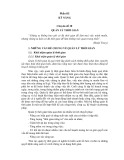
Chapter 17
Oligopoly
TRUE/FALSE
1. The essence of an oligopolistic market is that there are only a few sellers.
ANS: T DIF: 1 REF: 17-0
NAT: Analytic LOC: Oligopoly TOP: Oligopoly MSC: Definitional
2. Game theory is just as necessary for understanding competitive or monopoly markets as it is for understanding
oligopolistic markets.
ANS: F DIF: 2 REF: 17-0
NAT: Analytic LOC: Oligopoly TOP: Oligopoly | Game theory
MSC: Interpretive
3. In a competitive market, strategic interactions among the firms are not important.
ANS: T DIF: 1 REF: 17-0
NAT: Analytic LOC: Oligopoly TOP: Game theory | Competitive markets
MSC: Interpretive
4. For a firm, strategic interactions with other firms in the market become more important as the number of firms
in the market becomes larger.
ANS: F DIF: 2 REF: 17-0
NAT: Analytic LOC: Oligopoly TOP: Oligopoly | Game theory
MSC: Interpretive
5. Suppose three firms form a cartel and agree to charge a specific price for their output. Each individual firm
has an incentive to maintain the agreement because the firm’s individual profits will be the greatest under the
cartel arrangement.
ANS: F DIF: 2 REF: 17-1
NAT: Analytic LOC: Oligopoly TOP: Collusion MSC: Interpretive
6. If firms in an oligopoly agree to produce according to the monopoly outcome, they will produce the same level
of output as they would produce in a Nash equilibrium.
ANS: F DIF: 1 REF: 17-1
NAT: Analytic LOC: Oligopoly TOP: Oligopoly | Cooperation
MSC: Interpretive
7. Whether an oligopoly consists of 3 firms or 10 firms, the level of output likely will be the same.
ANS: F DIF: 2 REF: 17-1
NAT: Analytic LOC: Oligopoly TOP: Oligopoly MSC: Interpretive
8. Cartels with a small number of firms have a greater probability of reaching the monopoly outcome than do
cartels with a larger number of firms.
ANS: T DIF: 1 REF: 17-1
NAT: Analytic LOC: Oligopoly TOP: Cartels MSC: Interpretive
9. As the number of firms in an oligopoly becomes very large, the price effect disappears.
ANS: T DIF: 2 REF: 17-1
NAT: Analytic LOC: Oligopoly TOP: Oligopoly MSC: Interpretive
10. If all of the firms in an oligopoly successfully collude and form a cartel, then total profit for the cartel is equal
to what it would be if the market were a monopoly.
ANS: T DIF: 2 REF: 17-1
NAT: Analytic LOC: Oligopoly TOP: Cartels MSC: Interpretive
129

130 Chapter 17/Oligopoly
11. As the number of firms in an oligopoly increases, the magnitude of the price effect increases.
ANS: F DIF: 2 REF: 17-1
NAT: Analytic LOC: Oligopoly TOP: Oligopoly MSC: Interpretive
12. All examples of the prisoner’s dilemma game are characterized by one and only one Nash equilibrium.
ANS: F DIF: 3 REF: 17-2
NAT: Analytic LOC: Oligopoly TOP: Nash equilibrium | Prisoners' dilemma
MSC: Interpretive
13. If two players engaged in a prisoner’s dilemma game are likely to repeat the game, they are more likely to
cooperate than if they play the game only once.
ANS: T DIF: 2 REF: 17-2
NAT: Analytic LOC: Oligopoly TOP: Prisoners' dilemma
MSC: Interpretive
14. The story of the prisoners' dilemma contains a general lesson that applies to any group trying to maintain
cooperation among its members.
ANS: T DIF: 1 REF: 17-2
NAT: Analytic LOC: Oligopoly TOP: Prisoners' dilemma
MSC: Interpretive
15. In the prisoners' dilemma game, one prisoner is always better off confessing, no matter what the other prisoner
does.
ANS: T DIF: 1 REF: 17-2
NAT: Analytic LOC: Oligopoly TOP: Prisoners' dilemma
MSC: Interpretive
16. In the prisoners' dilemma game, confessing is a dominant strategy for each of the two prisoners.
ANS: T DIF: 2 REF: 17-2
NAT: Analytic LOC: Oligopoly TOP: Prisoners' dilemma | Dominant strategy
MSC: Interpretive
17. The game that oligopolists play in trying to reach the oligopoly outcome is similar to the game that the two
prisoners play in the prisoners' dilemma.
ANS: T DIF: 1 REF: 17-2
NAT: Analytic LOC: Oligopoly TOP: Game theory MSC: Interpretive
18. In the case of oligopolistic markets, self-interest makes cooperation difficult and it often leads to an
undesirable outcome for the firms that are involved.
ANS: T DIF: 1 REF: 17-2
NAT: Analytic LOC: Oligopoly TOP: Game theory MSC: Interpretive
19. When prisoners' dilemma games are repeated over and over, sometimes the threat of penalty causes both
parties to cooperate.
ANS: T DIF: 2 REF: 17-2
NAT: Analytic LOC: Oligopoly TOP: Prisoners' dilemma
MSC: Interpretive
20. A tit-for-tat strategy, in a repeated game, is one in which a player starts by cooperating and then does whatever
the other player did last time.
ANS: T DIF: 2 REF: 17-2
NAT: Analytic LOC: Oligopoly TOP: Game theory MSC: Definitional
21. One way that public policy encourages cooperation among oligopolists is through antitrust law.
ANS: F DIF: 1 REF: 17-3
NAT: Analytic LOC: Oligopoly TOP: Antitrust MSC: Interpretive

Chapter 17/Oligopoly 131
22. The Sherman Antitrust Act prohibits competing firms from even talking about fixing prices.
ANS: T DIF: 1 REF: 17-3
NAT: Analytic LOC: Oligopoly TOP: Sherman Antitrust Act of 1890
MSC: Interpretive
23. Resale price maintenance prevents retailers from competing on price.
ANS: T DIF: 1 REF: 17-3
NAT: Analytic LOC: Oligopoly TOP: Resale price maintenance
MSC: Interpretive
24. Some business practices that appear to reduce competition, such as resale price maintenance, may have
legitimate economic purposes.
ANS: T DIF: 2 REF: 17-3
NAT: Analytic LOC: Oligopoly TOP: Resale price maintenance
MSC: Interpretive
25. In 2007 the U.S. Supreme Court ruled that it was not necessary illegal for manufacturers and distributors to
agree on minimum retail prices.
ANS: T DIF: 2 REF: 17-3
NAT: Analytic LOC: Oligopoly TOP: Resale price maintenance
MSC: Definitional
26. Tying can be thought of as a form of price discrimination.
ANS: T DIF: 1 REF: 17-3
NAT: Analytic LOC: Oligopoly TOP: Tying MSC: Interpretive
27. Policymakers should be aggressive in using their powers to place limits on firm behavior, because business
practices that appear to reduce competition never have any legitimate purposes.
ANS: F DIF: 2 REF: 17-4
NAT: Analytic LOC: The role of government TOP: Antitrust
MSC: Interpretive
SHORT ANSWER
1. Even when allowed to collude, firms in an oligopoly may choose to cheat on their agreements with the rest of
the cartel. Why?
ANS:
Individual profits can be increased at the expense of group profits if individuals cheat on the cartel's cooperative
agreement.
DIF: 2 REF: 17-1 NAT: Analytic
LOC: Oligopoly TOP: Cartels MSC: Interpretive
2. What effect does the number of firms in an oligopoly have on the characteristics of the market?
ANS:
As the number of firms increases, the equilibrium quantity of goods provided increases and price falls; the market
begins to resemble a competitive one.
DIF: 2 REF: 17-1 NAT: Analytic
LOC: Oligopoly TOP: Oligopoly MSC: Analytical

132 Chapter 17/Oligopoly
3. Assume that demand for a product that is produced at zero marginal cost is reflected in the table below.
Quantity Price
0 $36
200 $33
400 $30
600 $27
800 $24
1000 $21
1200 $18
1400 $15
1600 $12
1800 $ 9
2000 $ 6
2200 $ 3
2400 $ 0
a. What is the profit-maximizing level of production for a group of oligopolistic firms that operate as a
cartel?
b. Assume that this market is characterized by a duopoly in which collusive agreements are illegal. What
market price and quantity will be associated with a Nash equilibrium?
ANS:
a. Q = 1200
b. Q = 1600, P = 12
DIF: 3 REF: 17-1 NAT: Analytic
LOC: Oligopoly TOP: Cartels MSC: Applicative
4. Describe the source of tension between cooperation and self-interest in a market characterized by oligopoly.
Use an example of an actual cartel arrangement to demonstrate why this tension creates instability in cartels.
ANS:
The source of the tension exists because total profits are maximized when oligopolists cooperate on price and
quantity by operating as a monopolist. However, individual profits can be gained by individuals cheating on their
cooperative agreement. This is why cooperative agreements among members of a cartel are inherently unstable. This
is evident in the problem OPEC experiences in enforcing the cooperative agreement on production and price of
crude oil.
DIF: 2 REF: 17-1 NAT: Analytic
LOC: Oligopoly TOP: Cartels MSC: Interpretive
5. Describe the output and price effects that influence the profit-maximizing decision faced by a firm in an
oligopoly market. How does this differ from output and price effects in a monopoly market?
ANS:
Output effect: Price > Marginal cost => increased output will add to profit
Price effect: increased quantity is sold at a lower price => lower revenue (profit?)
An oligopolist must take into account how the output and price effects will be influenced by competitors' production
decisions, or it must assume competitors' production will not change in response to its own actions.
DIF: 3 REF: 17-1 NAT: Analytic
LOC: Oligopoly TOP: Profit maximization | Oligopoly MSC: Interpretive

Chapter 17/Oligopoly 133
6. Explain how the output effect and the price effect influence the production decision of the individual
oligopolist.
ANS:
Since the individual oligopolist faces a downward-sloping demand curve, she realizes that if she increases output, all
output must be sold at a lower market price. As such, the revenue from selling the additional units at the lower
market price must exceed the loss in revenue from selling all previous units at the new lower price. Otherwise,
profits will fall as output (production) is increased.
DIF: 2 REF: 17-1 NAT: Analytic
LOC: Oligopoly TOP: Profit maximization | Oligopoly MSC: Interpretive
7. Ford and General Motors are considering expanding into the Vietnamese automobile market. Devise a simple
prisoners' dilemma game to demonstrate the strategic considerations that are relevant to this decision.
ANS:
The answer should present two strategies for each company, such as “Expand” and “Don’t Expand.” To be a
prisoner’s dilemma, each firm needs a dominant strategy, but each firm choosing its dominant strategy results in an
outcome that is jointly worse than if they both chose their other strategy. A possible payoff table with payoffs (Ford,
GM) is
GM
Expand Don’t Expand
Ford Expand (2, 2) (4, 1)
Don’t Expand (1, 4) (3, 3)
DIF: 3 REF: 17-2 NAT: Analytic
LOC: Oligopoly TOP: Prisoners' dilemma MSC: Applicative
8. Nike and Reebok (athletic shoe companies) are considering whether or not to advertise during the Super Bowl.
Devise a simple prisoners' dilemma game to demonstrate the strategic considerations that are relevant to this
decision. Does the repeated game scenario differ from a single period game? Is it possible that a repeated
game (without collusive agreements) could lead to an outcome that is better than a single-period game?
Explain the circumstances in which this may be true.
ANS:
The answer should show that if both shoe companies decide to advertise they will both be worse off than if they did
not. It should also show that each company has the individual incentive to advertise. The dominant strategy of both
companies will be to advertise, regardless of what the other is doing. If the game is repeated more than once it is
possible that the shoe companies will decide not to advertise in the hopes that the other company adequately
understands the mutually beneficial gains that come from not advertising.
DIF: 3 REF: 17-2 NAT: Analytic
LOC: Oligopoly TOP: Prisoners' dilemma MSC: Applicative
9. Outline the purpose of antitrust laws. What do they accomplish?
ANS:
The purpose of antitrust laws is to move markets toward a competitive equilibrium outcome. These laws are used to
prevent behavior that would lead to excessive market power by any single firm.
DIF: 2 REF: 17-3 NAT: Analytic
LOC: Oligopoly TOP: Antitrust MSC: Interpretive



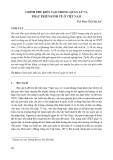
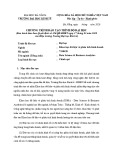
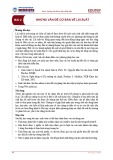
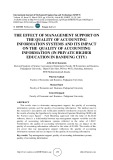
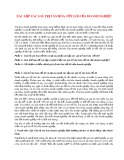
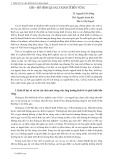
![Giáo trình Nền kinh tế công cộng [mới nhất]](https://cdn.tailieu.vn/images/document/thumbnail/2018/20180531/hpnguyen13/135x160/4911527762697.jpg)
